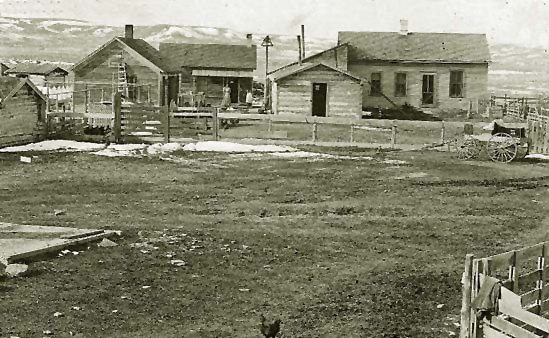
The MW Ranch, 1911, Stockade Creek, Weston County, Photo by John H. Leek .
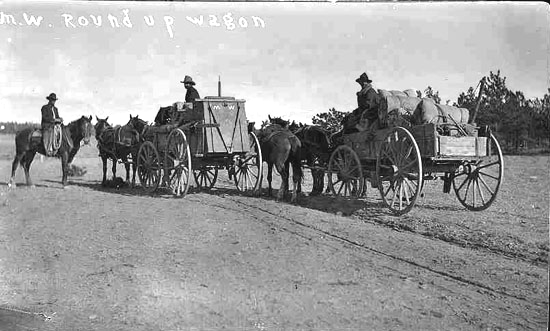
Chuck and hoodlum wagons, M W roundup, 1911, Photo by John H. Leek (attributed).
In addition to the chuckwagons, outfits would have a "hoodlum" wagon which would carry
bedrolls and other gear. Branding irons would typically be carried beneath the hoodlum wagon.
Foodstuffs included dry salt port, beans, Arbuckle's coffee, dried fruit, and potatoes. The cook would make sourdough
bread and baking powder bisuits. A special treat might be "spotted pup," a steamed rice and
raisin pudding made in a flour sack hanging from a stick over a pot of boiling water. In addition to the wagons belonging to a single
outfit, smaller ranches would join together and run a "pool" wagon in which they would share the
expenses such as the grub.
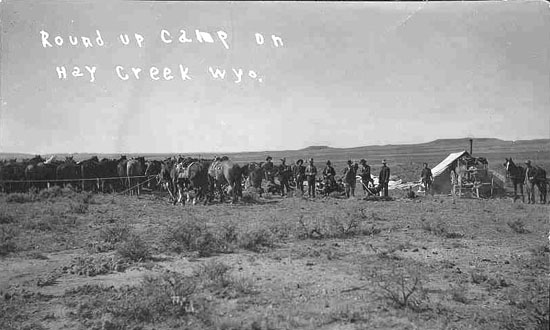
MW Fall Roundup Camp near Hay Creek, 1911, Photo by John H.
Leek (attributed).
The M W was owned by John E. Mead. The M W. ran both sheep and cattle in Niobrara, Weston, and Crook Counties,
as well as far east as Pine Ridge, South Dakota.
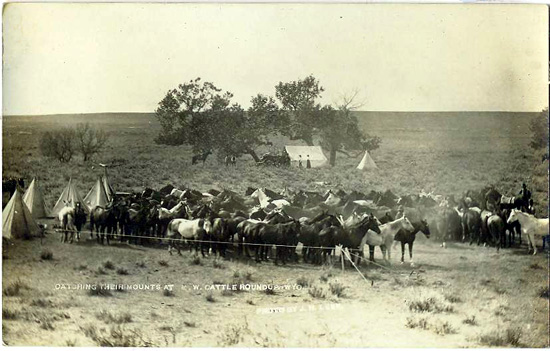
Remuda, M W Roundup, 1911, Photo by John H.
Leek.
On April 7, 1930, John Mead was killed in a confrontation with Leary C. Wolf southwest of Newcastle. Mead and his son Keith had gone into town for
supplies for a cowcamp. On the return, they noticed that gates had been left open on both the fron and rear of one pasture. They came across a car parked along
side the road. In the car was Leary C. Wolf. The confrontation occurred when the Mead automobile stopped. Leary then shot the elder Mead through
the chest three times. Keith leaped through the window of Wolf's car. Wolf was holding two guns. A struggle ensured for the guns, In the struggle,
one of Wolf's guns discharged with a bullet going through one of Keith's sleeves. Keith was able to grab one of the guns and beat Wolf with the butt of the gun. In the struggle, Wolf
received a fractured skull, broken jaw and shoulder blade. The elder Mead died upon the scene.
Wolf expired two days later. Newspaper wire service accounts noted that a feud had been going on between
Mead and Wolf for twenty-five years and that Mead ran both cattle and sheep. Wolf ran only cattle.
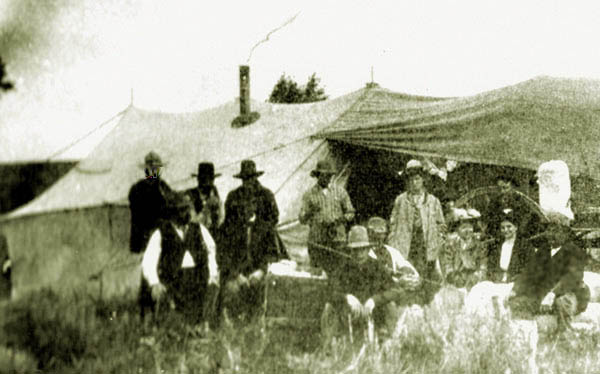
Pemberton & Cowden Cattle Company Wagon near Little Powder River, 1900. The General Manager and part owner,
George Allen Pemberton, seated at the right. Note the stove pipe emerging from the mess tent.
As indicated on previous pages, on roundup and on trail drives the cooks would generally use dutch ovens over an open fire to cook.
On some roundups where a cowcamp was not anticipated to move frequently, an occasional stove was used. as depicted in the photo. .
George A. Pemberton (1859-1938) although born in Missouri, was regarded as a Texas cowboy who came up the trail from
Rumnels County, Texas. The business model for Pemberton was purchase of cattle in West Texas and shipping to Belle Fource by rail and then fattening them
up along the Belle Fource and Little Powder Rivers for shipment and sale in Chicago. Pemberton was also the president of the
American National Bank of Spearfish. In 1901, Pemberton & Cowden shipped 75 carload of Cattle from Portale, New Mexico to Belle Fourche.
But by 1903, the warning signed began to appear. According to the August 3, Chicago Livestock World, at the beginning of the season, Pemberton shipped
ten carload to Chicago with another 25 car loads expected. By 1908, Livestock World reported that there were fewer Texas cattle being
purchased. The "decrease," the paper reported, "shows the gradual ending of its inducstry and is an index of the changed condition."
By 1911, the operation closed and George Pemberton moved to Denver.
Carrying a stove to roundup required the use of a "stove wagon."
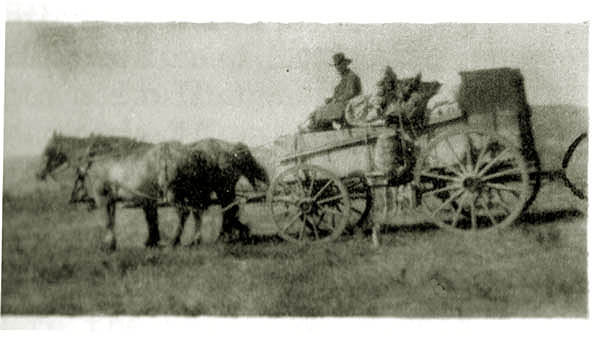
Stove Wagon, undated, John Keliher (1856-1910) on the reins.
Once the stove was put in place in the mess tent, the stove wagon could be put to other uses. Thus, when Albert Walker
On roundup after the cattle were separated by brand, it was necessary to get them back to their home range. This required a separate wagon known as a
"thoughback wagon." George Philip (1880-1947) explained:
It somethimes happened that the winter storms were such that the cattle drifted in great numbers, and for great distances fromtheir usual range.
In such cases a throw back wagonwould be run in conjunction with a big roundup outfit. A throwback, or to throwback;, meant the
process by which catle picked up on the range were taken back to that particular part of the range on which they were said to belong. When it was known that such cattle would be
picked up in considerable numbers the business of getting them back to their own range was
expedited by the use of the "thowback" wagon. Sometimes a large outfit * * *would rig up a throwback wagon of its own, with its own men * * *." By reason of the cattle drifts, the
throwback wagons always went north with cattle and went south without any. When a throwbacck wagon was not employed then it became
the task of a rep working with a oundup to work his cattle back to where they belonged * * */"
As quoted in Hall, Bert L., Roundup Years, Old Muddy to Black Hills, First Printing 1954, p, 124
Philip, born in Scotland, came to the United States at age 17 and worked in Colorado lumber camps. Philip rode range from 1899 to 1903. He graduated from the University of Michigan and became a lawyer at
Fort Pierre. He was United States Attorney for South Dakota from 1934 until 1947.
With the coming of smaller ranches and barbed wire, by the early years of the Twentieth Century the era
of large roundups came to an end. Albert Gallatin Brown of the Brown Cattle Co. recalled the last
big roundup along the Rosebud and the Upper Tongue River north of Sheridan. The roundup, held in
1904, consisted of Nine wagons working together. Somethimes a hundred and fifty men would work a circle, with three or
and four roundups at the same time, "reps from all over our cattle world."
Setlement killed the large roundups. As observed by John
Clay, the settlers were too much, "you can fight armies or disease or trepass, but the settler never.
He advances slowly, surely, silently, like a great motor truck, pushing everything before him."
|